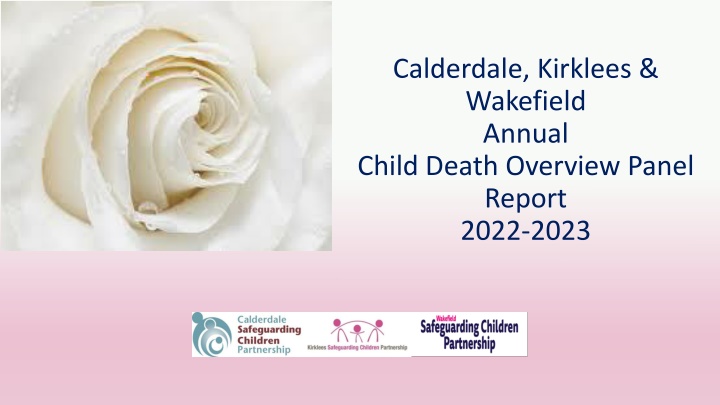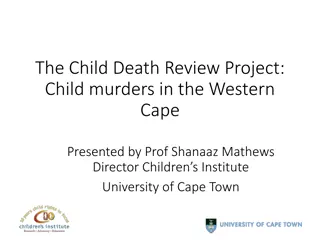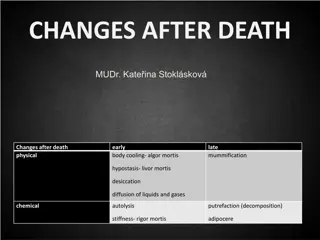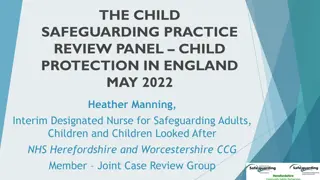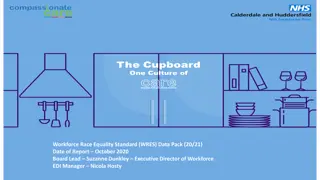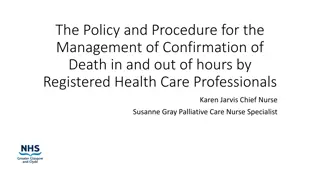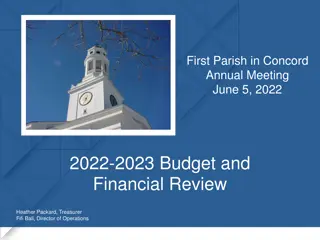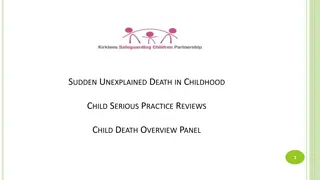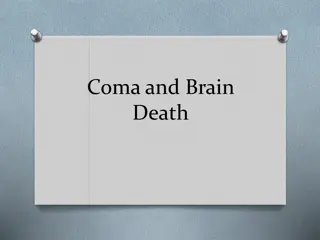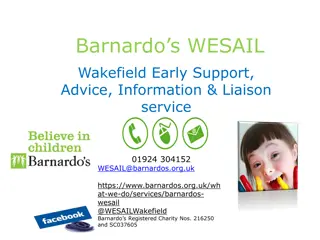Annual Child Death Overview Panel Report 2022-2023 for Calderdale, Kirklees, and Wakefield
The Annual Child Death Overview Panel Report for Calderdale, Kirklees, and Wakefield highlights the review process for unexpected and expected child deaths. The report emphasizes the importance of learning from each death to prevent similar tragedies in the future, sharing findings regionally and nationally, and implementing targeted interventions. The process involves a Joint Agency Response meeting for unexpected deaths and reporting forms for expected deaths to identify modifiable factors. The report aims to improve child safeguarding practices and reduce avoidable deaths.
Download Presentation

Please find below an Image/Link to download the presentation.
The content on the website is provided AS IS for your information and personal use only. It may not be sold, licensed, or shared on other websites without obtaining consent from the author.If you encounter any issues during the download, it is possible that the publisher has removed the file from their server.
You are allowed to download the files provided on this website for personal or commercial use, subject to the condition that they are used lawfully. All files are the property of their respective owners.
The content on the website is provided AS IS for your information and personal use only. It may not be sold, licensed, or shared on other websites without obtaining consent from the author.
E N D
Presentation Transcript
Calderdale, Kirklees & Wakefield Annual Child Death Overview Panel Report 2022-2023
Contents Introduction 3 CDOP Process 4 - 6 Membership and Panel Meetings 7 - 8 What have we Achieved 9 12 Modifiable Factors Document Across Kirklees, Calderdale and Wakefield 13 - 14 Priorities for 2022/23 15 Kirklees Data 16 Calderdale Data 17 Wakefield Data 18 Pan CDOP Categories of Death 19 Joint Data and Analysis 20-24 Conclusion 25 2
Introduction From 1st April 2008, all deaths of children (up to the age of 18 years, excluding still births and planned terminations) are reviewed by a Panel of professionals from a range of organisations and expertise. This review is part of a national process called the Child Death Overview Panel (CDOP) which is outlined in national guidance (Working Together to Safeguard Children, 2018). This process is undertaken locally for all children who are normally resident in Calderdale, Kirklees, and Wakefield. Every death of a child is a tragedy and we must therefore learn from the circumstances and factors present in each death so we can: Identify any changes that we can make or actions we can take that might help to prevent similar deaths in the future. Share this learning with colleagues regionally and nationally so that the findings will have a wider impact. Analyse trends and targeted interventions delivered in response to these. For example, introducing the requirement to view where a baby sleeps as part of routine enquiry by Health Visiting and Midwifery services, if there have been a spate of deaths where unsafe sleeping practices have been a factor. It could also include launching a targeted water safety campaign aimed at children and young people if there have been deaths due to drowning. The deaths reviewed by the CDOP are not about allocating blame, it is instead about learning and putting actions in place to prevent future deaths. 3
CDOP Process Unexpected deaths An unexpected death is defined as the death of an infant or child (less than 18 years old) which was not anticipated as a significant possibility, for example, 24 hours before the death; or where there was a similarly unexpected collapse or incident leading to or precipitating the events which lead to the death. When an unexpected child death occurs there are specific actions that must be taken by professionals. A Joint Agency Response (JAR) meeting will take place within 72 hours of the death. This meeting will be coordinated by the appropriate Child Death Review partner i.e. Police or Consultant Paediatrician. The purpose of the JAR (sometimes referred to as a rapid response) meeting is to enable the sharing of information, multi-agency discussion and planning to safeguard other individuals if identified. Expected deaths An expected death is defined as the death of an infant or child which was anticipated following on from a period of illness that has been identified as terminal, and where no active intervention to prolong life is ongoing. The process for expected deaths differs slightly as they do not normally require a JAR. When a notification is received by CDOP, each agency that knew the child prior to their death receives a Reporting Form (or Form B). This form captures all the relevant information about the child and family to inform the CDOP process when considering modifiable factors. This process does not have a multi-agency discussion. 4
Inquests held It is the Coroner s responsibility to determine the cause of death where this is not known. If it is not possible to find out the cause of death from the post-mortem examination, or the death is found to be unnatural, the Coroner holds an inquest which is a public court hearing held by the Coroner in order to establish who died and how, when and where the death occurred. Child Death Review Meetings All expected and unexpected child deaths are required to have a Child Death Review (CDR) meeting. This is a multi-agency meeting where all matters relating to an individual child are discussed by professionals directly involved in the care of the child during their life. A CDR meeting can take many forms such as a Local Case Discussion, Perinatal Mortality Meeting, an NHS Serious Incident Investigation or a Hospital Morbidity and Mortality meeting and typically, this meeting happens three months or more following the death of a child. 5
CDOP Panel Once all of the previous stages have been completed and when the cause of the child s death has been determined for both expected and unexpected child deaths, this information is taken to the Child Death Overview Panel (CDOP) for discussion and review. All the strategic leads from across the organisations (Public Health, Health, Social Care and Police) are represented at the meeting, along with the CDOP Coordinator and the Designated Doctor for Child Deaths. The purpose of the CDOP is to consider any learning or factors that could prevent future deaths of children. The information taken to Panel is anonymised. During 2022/2023, the Calderdale, Kirklees and Wakefield CDOP s reviewed a total of 65 cases. There are many reasons why it can take more than 6 months for a child death to be reviewed by the CDOP; one reason may be that information from agencies is still outstanding so the case cannot be progressed. In addition, if there is an on-going investigation (for example a Police investigation, Child Safeguarding Practice Reviews and Inquests) then discussions may be deferred pending the result of the inquiries. It must be noted that a child s death cannot be discussed at CDOP until all information is received. 6
Membership and Panel Meetings Panel Arrangements Calderdale, Kirklees and Wakefield share arrangements for reviewing the deaths of all children in these areas. During 2022/23 the pan CDOP has continued to use the eCDOP system for all child death notifications and to send out the subsequent Reporting Forms to the services who were involved with the child and family. Services can quickly report back at the click of a button if the child and family is not know to them, so we can quickly build up a picture of which services were involved with the child s care. Panel Meetings CDOP meetings continue to be held virtually. They are well attended by a wide range of multi-agency professionals. This ensured that any learning and actions to come from a child s death could be identified and shared without delay, helping to prevent future deaths. CDOP Coordinators ensure that the documentation to be discussed at the CDOP meeting is circulated in advance so members have time to review it and come ready to give their input and feedback. 7
Panel Membership The Panel meetings are held every two months and have had consistent organisational commitment since they were established in 2008. The joint Chairs of the CDOP meetings are Ben Leaman, Consultant in Public Health, Calderdale. Emily Parry-Harries, Consultant in Public Health, Kirklees and Melanie Robinson, Service Manager, Children s Public Health, Wakefield. 8
Priorities for 2023/2024 The following have been identified as priorities for the Panel for the year ahead: Priority 1 Priority 1: To continue to provide safe sleeping training for professionals so that information can be shared with families 2023/2024 Priorities Priority 4 Priority 2 Priority 2: Continued focus on reducing population level smoking rates across Kirklees/Calderdale and Wakefield with a particular focus on reducing smoking in pregnancy Priority 3: Continue to build upon and strengthen existing child death review processes. Priority 3 Priority 4: Continuing to develop the partnership arrangements across the shared panels 9
Reflecting back on our identified priorities Priority 1: KCW exploration of potential roll out of the safe sleep training for the workforce. Launch of a public facing safe sleep campaign across KCW. Priority 2: Continued focus on reducing population level smoking rates across KCW, with a particular focus on reducing smoking in pregnancy. Priority 3: Continue to build upon and strengthen existing child death review processes. Priority 4: Modifiable Factors decision making across KCW to be reviewed to ensure consistency. 10
What we have achieved: Priority 1- KCW exploration of potential roll out of the safe sleep training for the workforce. Launch of a public facing safe sleep campaign across KCW. Resources were shared in Safer Sleep Week 13th-19th March 2023 using The Lullaby Trust resources on social media as the theme was co-sleeping which has been identified as a modifiable risk factor for SUDI. WY Local Maternity & Neonatal System (LMNS) delivered a Every Sleep a Safe Sleep (ESaSS) Train the Trainer session on 23 May 2023 and 20 colleagues attended from Wakefield including Midwifery, Safeguarding, Family Hubs and the Police. There are now around 100 ESaSS trainers across the health and care sectors, frontline and emergency services, educational settings and housing and benefits organisations. Conversations are ongoing regarding embedding ESaSS training in educational and primary care networks to enhance early awareness. Some national recognition is emerging on ESaSS, linking in to the Durham Sleep project led by Prof Helen Ball, for instance. Information on the programme and training opportunity communications are distributed through the Families Together network in Kirklees, the Improving Population Health Programme updates, WYHCP bulletins, and local place-based comms networks. Due to the large geographical area and complexities of the training being multi-agency it was felt that each area would look at this training individually same for the Safe Sleep Campaigns as the LMS was not in position to lead the work. Every Sleep a Safe Sleep training has continued to be taken forward locally as a train the trainer offer with the training then being cascaded in the relevant teams. We are working with colleagues in safeguarding and health visiting to explore how the approach can be embedded in Calderdale as a multi- agency training offer and how the training will form part of the Family Hubs workforce offer. Work is required to capture the number of people trained and embed the multiagency training as a rolling programme. A paper about the Safer Sleep Training went to the Starting Well Board in June 2022 and will be revisited at the meeting in October 2023. 11
What we have achieved Priority 2 - Continued focus on reducing population level smoking rates across KCW, with a particular focus on reducing smoking in pregnancy In Wakefield Smoking in Pregnancy (SIP) has fallen to its lowest ever rate of 12.2%. The Saving Babies Lives Care Bundle (Version 3) has now been published and added to the document: Element 1 on Reducing smoking during pregnancy now includes the full Long Term Plan tobacco treatment pathway, in addition to CO testing and opt-out referral as in the previous versions. Smoking in pregnancy continues to remain a priority. Within Kirklees, Public Health there is a dedicated service, Auntie Pam s, to support women of childbearing age, which includes smoking cessation support at pre-conception, pregnancy, and perinatal stages. Full document from NHS E can be accessed here https://www.england.nhs.uk/publication/saving-babies-lives-version- three/ Calderdale is higher than the England average (9.6% 2020/21) for the percentage of women who are known smokers at delivery. The proportion for Calderdale overall has varied slightly since 2016/17, and this most recent figure is lower than the 14% recorded in 2019/20. At ward level, there are some clear variations with Ovenden and Illingworth and Mixenden recording the highest levels (29.7% and 25% respectively). A Smokefree Pregnancy Service launched in October 2022 with two named Maternity Support Workers (MSAs) who are Health Advisers. These posts are funded from the NHS Long Term Plan funding that was given to CHFT. They cover other aspects of health as well as smoking cessation. Nicotine replacements such as patches and gum which are available free of charge from the Maternity Health Advisers. They also offer to arrange support for other family members to stop smoking. Yorkshire Smokefree (YSF) still support partners of pregnant women and pregnant women wanting to access vapes through the vape pilot (the MSWs refer these smokers on to YSF). 12
What we have achieved Priority 3 - Continue to build upon and strengthen existing child death review processes. Calderdale and Huddersfield foundation trust (CHFT) have commissioned a full time Child Death Lead Nurse covering the Calderdale and South Kirklees footprint as a 50/50 split between both areas. This appointment helps to ensure both Kirklees and Calderdale are compliant with CDOP/child death guidance particularly around child death review processes. The Child Death Lead Nurse also acts as a key worker for the bereaved family and provides support, not only as they come to terms with the death of their child, but as they navigate their way through child death review processes such as the post-mortem and Coroner s Inquests. There is continued support from the National Child Mortality Database (NCMD) in the completion of analysis forms to ensure accuracy of information which forms the basis of future thematic reports. NCMD have also provided guidance documents on: Contributory factors and database changes - October 2022 Guidance on recording consanguinity January 2023 Advice for GPs following the death of a child August 2022 13
What we have achieved Priority 4 - Modifiable Factors decision making across KCW to be reviewed to ensure consistency. Kirklees Public Health has continued to take the lead during the year to create a spreadsheet which has identified the leading modifiable factors of the cases reviewed. By using this it has been possible to identify gaps in service along with proposed future work and work already ongoing with families. Partners from Public Health in KCW attend the CDOP meetings and look at recurring themes and ways to work together at place on a prevention approach. This includes updating the Modifiable Factors document with any new information and ensuring the document is referred to in practice but also used to evidence work ongoing. 14
Modifiable Factors Across Calderdale, Kirklees & Wakefield Background: Of the 65 cases the Panel reviewed in 2022/23, there were 44 cases where modifiable factors were present. This represents an average of 64%, whereas the average for England at that time was 39%. Modifiable factors were identified and discussed in Panel meetings, with an overarching monitoring and analysis log being developed and introduced to provide assurance to the CDOP that work is in progress to address the identified modifiable factors. It has been identified that the method of recording consanguious marriages may have been incorrect, a working party have reviewed the link between modifiability and consanguinity and a flowchart has been created to assist in accurate decision making. 15
Kirklees Data During 2022/2023 there have been 49 deaths reported in Kirklees. During the year 32 cases have been reviewed and completed. There are a further 66 cases to be reviewed. Cases completed with cause of Death: Causes of death Sudden unexpected, unexplained death Of the cases reviewed 19 (41%) had modifiable factors, the Perintatal/neonatal event top 4 of which were (in order) 1 2 3 1 Chromosomal, genetic and congenital anomolies Chronic medical condition Smoking (6) Consanguinity (5) 8 4 Malignancy Unsafe sleeping arrangements (2) Acute medical or surgical condition 2 Organizational Issues (2) Infection 11 Suicide or delberate, self inflicted harm Other modifiable factors noted by Kirklees but not recognised as a theme were drug & alcohol abuse, deprivation, parental mental health and domestic abuse. 16 (each case can have more than one modifiable factor identified)
Calderdale Data During 2022/2023 there have been 14 deaths recorded, which is in line with previous years. During the year 16 cases have been reviewed and completed, with a further 14 cases to be reviewed. Cases Completed with cause of death: Causes of Death Chromosomal, genetic or congenital anomolies Of the cases reviewed 12 (75%) had modifiable factors, 1 1 Perinatal/neonatal and these have been identified as: 5 1 Sudden unexpected, unexplained death Consanguinity 7 Smoking 3 Service Provision COVID related 2 Lack of safety equipment 1 Maternal Obesity 1 Lack of parental prescribed medication 1 Traumatic Event 2 Acute medical medical or surgical condition Chronic medical condition 2 Infection 4 (each case can have more than one modifiable factor identified) 17
Wakefield Data During 2022/2023 there have been 23 deaths recorded. During the year 17 cases have been reviewed and completed, with a further 40 cases to be reviewed. Cases Completed with cause of death: Causes of death Of the cases reviewed, 7 had modifiable factors (41%), and these have been identified as including: Sudden unexpected, unexplained death Perintatal/neonatal event Factors identified which may have contributed to ill-health or a death Parental Smoking - 5 Parental alcohol use -1 Parental substance misuse - 1 Co-sleeping - 1 Room Temperature - 1 Access to medication - 1 Child Obesity (high BMI) - 1 1 2 1 Chromosomal, genetic and congenital anomolies 3 3 Chronic medical condition Malignancy 2 Trauma and other external factors, including medical /surgical Factors identified but has not contributed to a death Smoking in early pregnancy - 1 Parental substance misuse - 1 Domestic violence 2 5 Acute medical or surgical condition (each case can have more than one modifiable factor identified) 18
Categories of Death for Pan CDOP - Cases Reviewed In Year 2022/23 12 11 10 8 8 6 5 5 4 4 4 3 3 3 2 2 2 2 2 2 2 2 1 1 1 1 1 1 0 0 0 0 0 0 Kirklees Calderdale Wakefield 19
Age of Children Reviewed in 2022/23 Joint Data and Analysis 9% 11% Age of children: 37% 11% A child is most at risk of death within the first year of life, and particularly within the first 27 days of life. 14% 18% There are many reasons for the causes of death during the first 27 days of life, but there are also children who die where the cause is unknown. These cases are referred to the Coroner, to determine through the Coronial process the child s cause of death. 0-27 days 5-9 years 28 - 364 days 10 - 14 years 1 - 4 years 15 - 17 years Child Age & Category of Death 55% of children in the pan CDOP died within their 1st year of life. The lowest age group of children who have died are 15-17 year olds which is a change from 2021/22 when 5-9 year olds was the lowest category. TRAUMA & OTHER EXTERNAL FACTORS, SUICIDE OR DELIBERATE SELF-INFLICTED HARM SUDDEN UNEXPECTED, UNEXPLAINED DEATH PERINATAL/NEONATAL EVENT Of all the children who have died, 37% died within 27 days of birth and the main category of death for this age group continues to be chromosomal, genetic and congenital anomalies, a perinatal/neonatal event or SUDIC. MALIGNANCY INFECTION DELIBERATELY INFLICTED INJURY, ABUSE OR CHRONIC MEDICAL CONDITION CHROMOSOMAL, GENETIC & CONGENITAL ACUTE MEDICAL OR SURGICAL CONDITION 20 0 - 27 Days 28 - 364 Days 1 - 4 Yrs 5 - 9 Yrs 10 - 14 Yrs 15 - 17 Yrs
Ethnicity of Children Reviewed 22/23 Joint Data and Analysis 40 29 30 26 Ethnicity: 20 Across the pan CDOP when looking at the ethnicity of the child deaths along with the category of deaths, the largest category of death was chromosomal, genetic and congenital anomalies. There is a 36% split between White children and Asian/British Asian children with the remainder either unknown or of Black or Black Asian ethnicity. 10 4 3 2 1 0 White Unknown Other Mixed Black or British Asian Asian or Asian British Total Ethnicity & Category of Death Trauma & other external factors, including Suicide or deliberate self-inflicted harm Sudden unexpected, unexplained death This is consistent with the 2020/21 data which saw chromosomal, genetic and congenital anomalies as the main category of death split 40% between White children and Asian/British Asian children and the remainder were unknown or mixed. Therefore there hasn t been a significant change. Perinatal/neonatal event Malignancy Infection Deliberately inflicted injury, abuse or neglect Chronic medical condition Chromosomal, genetic & congenital Acute medical or surgical condition 0 5 10 15 20 25 White Unknown Other Mixed Black or Black British Asian or Asian British 21
Gender of Children Reviewed 22/23 Joint Data and Analysis 50 39 40 Gender: 26 30 20 This year the gender split between the children who have died is larger at 62% males and 38% females compared to 2021/22 when there was a more equal split (53% males compared to 47% females). 10 0 Male Female Gender 14 12 12 12 10 10 10 Location of death: 10 8 Of the 65 cases reviewed, 78% of the deaths occurred in a medical setting. With one in six who died at home. These figures are comparable to 2021/2022. 6 6 4 1 1 1 1 1 2 0 0 0 0 0 22
Joint Data and Analysis Modifiable Factors Modifiable factors are defined as those, where, if actions could be taken through national or local interventions, the risk of future child deaths could be reduced When the Panel has reviewed the death of a child they will then identify and agree any modifiable factors that may have prevented the death. Out of the 65 child deaths reviewed by the Panels during 2022/2023, there were 38 cases where modifiable factors were identified. This represents an average of 58%, (6.5% increase from 21/22 51.5%) whereas the average for England is 39% (based on NCMD Monitoring Q4 22/23 Report) Of the 65 child deaths reviewed where modifiable factors were identified, the predominant factors recorded were: Smoking Consanguinity Organizational issues Domestic Abuse Unsafe sleeping Arrangements 23
Indices of Deprivation Nationally The most common age at death was less than 1 year (63%) and more boys than girls died (56.5% vs 43.5%), while the majority of children who died lived in urban areas (87.8%). By linking each child s address to the UK government s ten deciles of deprivation (calculated using seven indicators of income, employment, education, health, crime, access to housing and services, and living environment), it was determined that child mortality increased as deprivation increased. More specifically, on average, there was a 10% increase in the risk of death between each decile* of increasing deprivation. State of the Nation Locally Kirklees: Of the 49 children who died in 2022/2023, 33 had been resident in the 2 most deprived areas in Kirklees which are urban (67%). 61% were female and 39% were male. 54.5 % of children were of Asian/Asian British Pakistani ethnicity. Calderdale: Of the 14 children who died in 2022/23, 6 had been resident in the 2 most deprived areas of Calderdale which are urban (43%). 66% were male and 33% were female. 50% of children were of Asian/Asian British Pakistani ethnicity. Wakefield: Of the 23 children who died in 2022/23, 7 had been resident in the 2 most deprived areas of Wakefield which are urban (31%). 57% we male and 43% were female. 72% of children were of White ethnicity. 24
Conclusion Although the number of cases reviewed in 2022/23 (65) have been less than the previous year 2021/22(101) this this has still been an increase on earlier years. Some of the delays in respect of CDOP processes have been addressed and we continue to improve the process. The majority of children who die do so before the age of 1 (55%). 37% were aged 28 364 days, 18% aged 0 27 days. The main category of death for this age group continues to be chromosomal, genetic and congenital anomalies, a perinatal/neonatal event or SUDIC. Of the 65 deaths reviewed, 39 were male and 26 were female This is consistent with the findings from 2021/22, where there were also more male than female deaths. Inequalities and the links to child deaths will continue to be a focus across KCW. Inequalities are a golden thread in everything the Panel does, monitoring this will allow targeted work to be undertaken where inequality can be a contributory factor to the death e.g. poverty and safer sleep. 25
The categories CDOP has recorded child deaths against in 2022/23 remained the 3 same categories to 2020/21 and 2021/22 but saw some percentile variances. Annual Comparisons 25 20 15 10 5 0 Chromosomal, genetic & Congenital Deliberately inflicted injury Suicide Trauma Malignancy Acute medical Chronic Medical Perinatel/neonatal Infection SUDIC 20/21 0 0 1 2 3 3 8 5 2 4 21/22 0 2 6 4 6 9 19 14 4 2 22/23 0 1 3 7 3 6 22 16 9 8 20/21 21/22 22/23 26
There has been an increase in the percentage (~10%) of deaths in 2021/22 in comparison to 2020/21 where modifiable factors were present (51.51% v 41.3%). Part of this increase can be attributed to the system developments districts have undertaken in relation to CDOP processes which has resulted in deaths being reviewed more effectively and in greater volume. Wakefield reviewed 25 deaths in 2021/22 in comparison to 7 deaths in 2020/21. Kirklees reviewed 52 in 2021/22 compared to 29 in 2020/21. Calderdale reviewed 24 deaths in 2021/22 compared to 10 in 2020/21. Inequalities and the links to child deaths will continue to be a focus across KCW. Inequalities are a golden thread in everything the Panel does, monitoring this will allow targeted work to be undertaken where inequality can be a contributory factor to the death e.g. poverty and safer sleep. Perinatal/neonatal event continues to be the highest category used by CDOPs nationally (based on NCMD Annual Report 20/21 21/22 report awaiting publishing). 27
